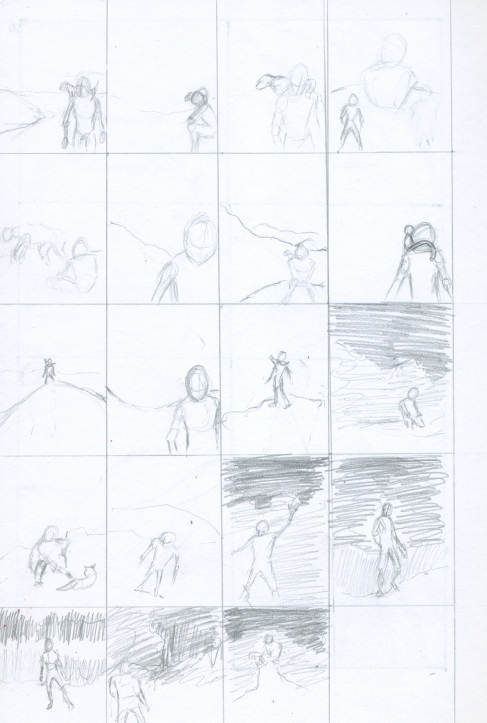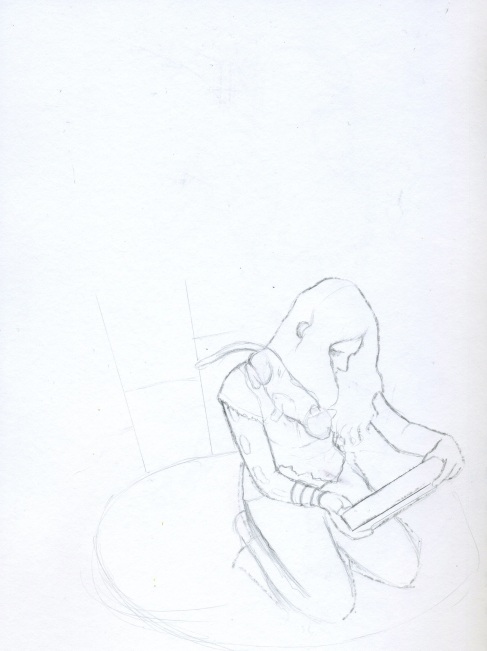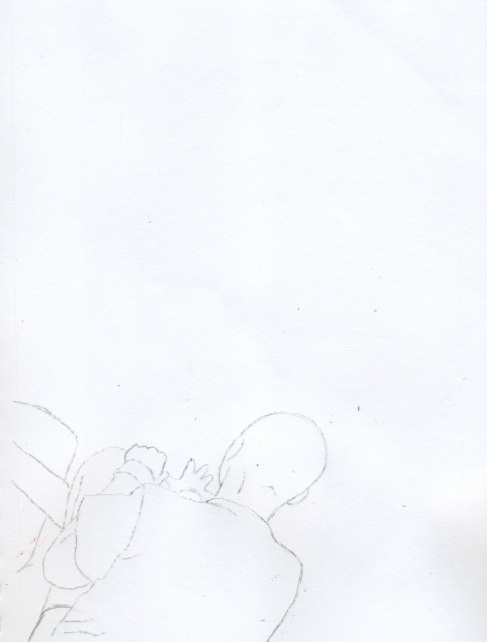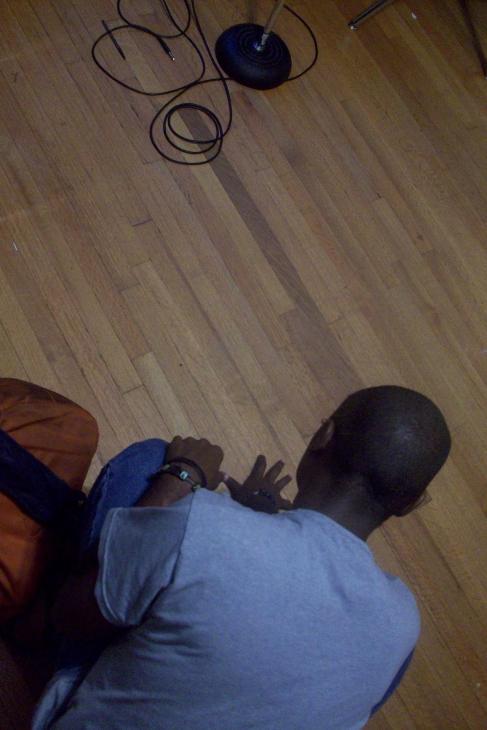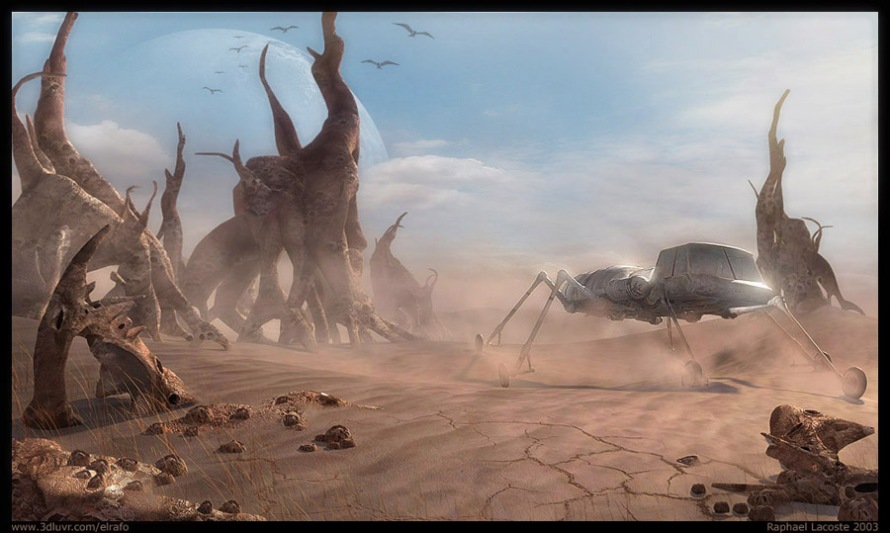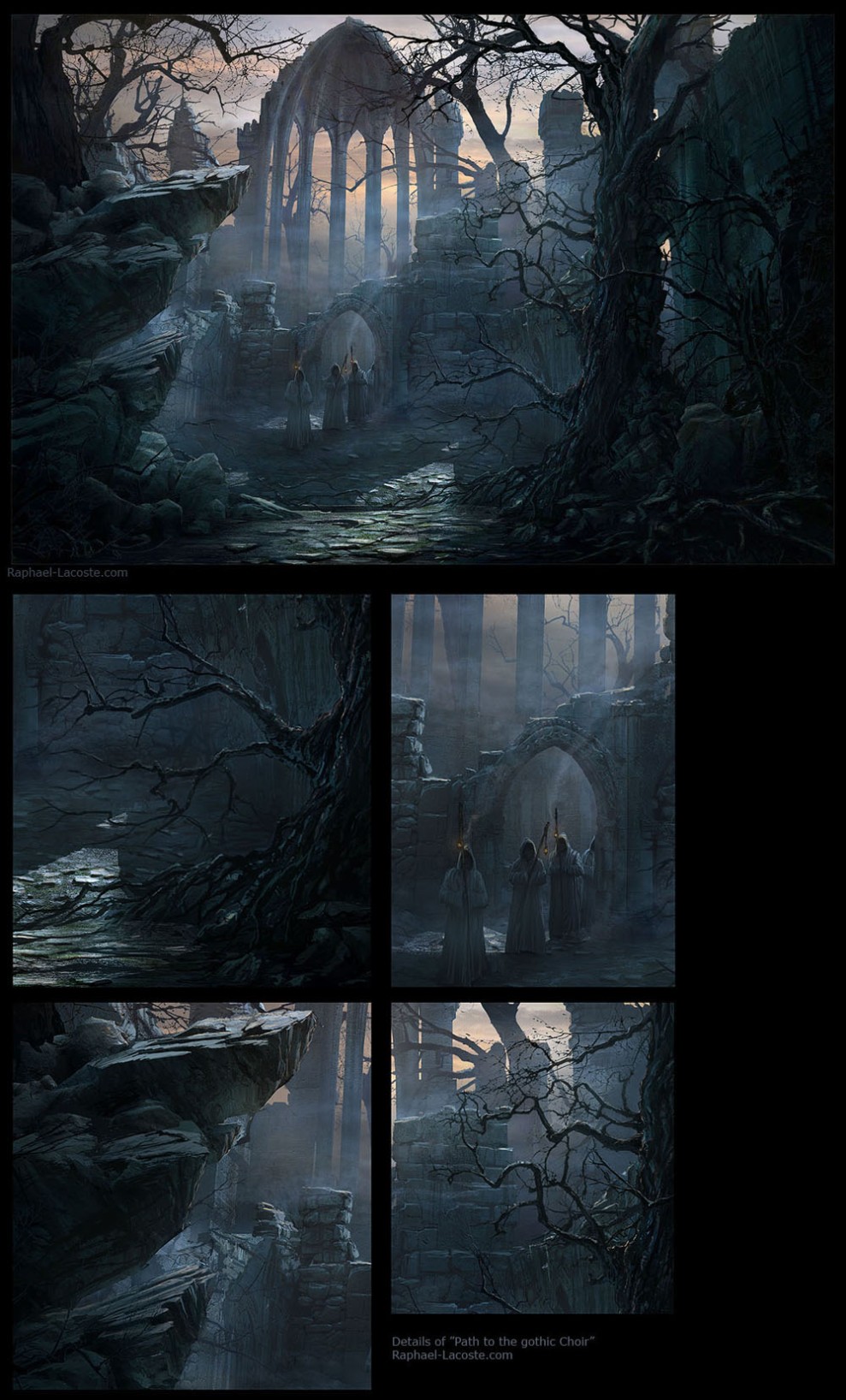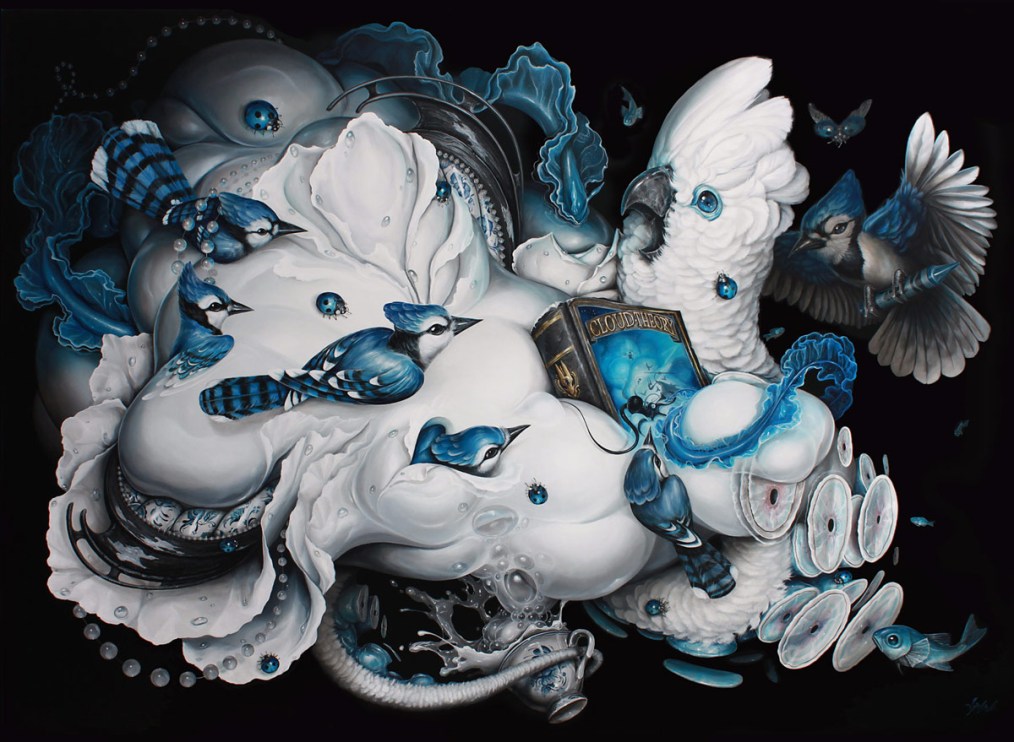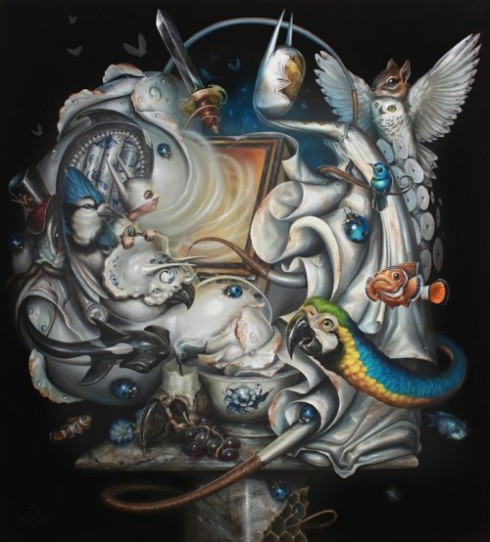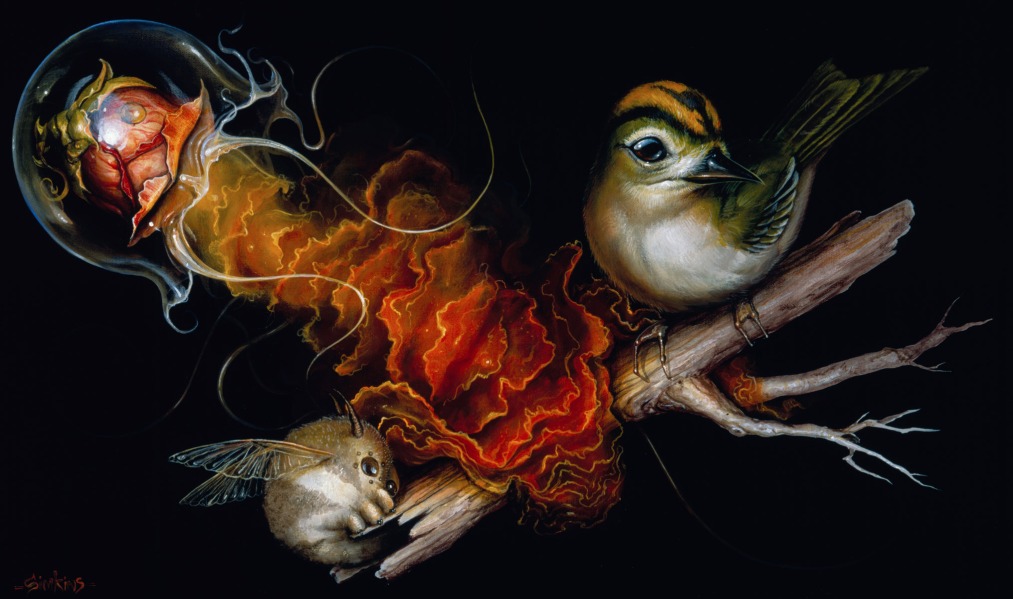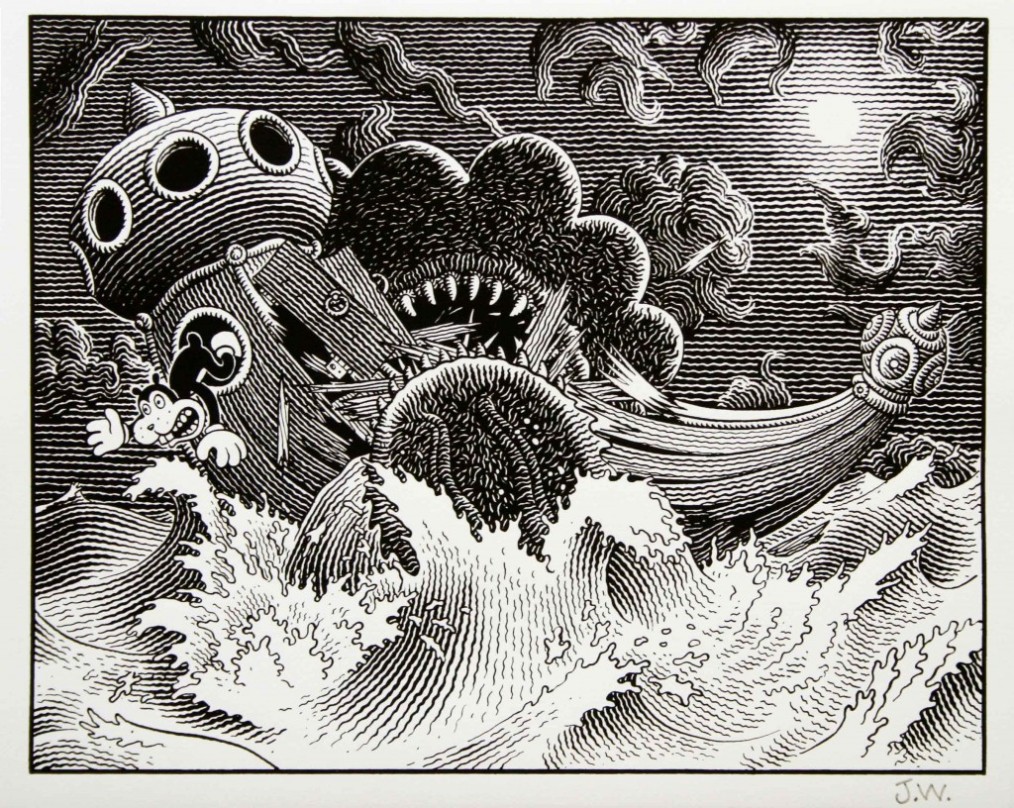For this assignment I decided to continue with the e-waste series, but I want to put more focus on possible characters. Through their eyes, I want to show a world of machine and electronic waste. WIth the characters, I want them to be individuals. I’m going to show this by expressing it through their clothing to the way they interact with the world.
I’m going to continue to use acrylic paint. Having doing so, I feel like am getting a better “grip” on a technique that works for me. I’ve been looking at artists such as Greg Simkins (Craola) and Raphael Lacoste to understand their techniques. I found it really helpful with helping me making proper steps before just jumping right into the painting process. Also, I’ve been giving a lot more careful attention to my reference images. I collect a lot more reference photos and images now. From there, I narrow them down to want i want to use. Another thing I’ve been doing is making more models. I’ve use everything from just simple cube shapes to full form figures.
Raphael Lacoste
Raphael Lacoste lives in Canada, Montreal, with his family since 2002. He was born in 1974 in Paris, but lived mostly around Bordeaux, south west of France until he left for Canada.
He studied in 1993 at Fine Arts school, Art and Media option, Photography and Video, at the same time, he was photographer and composer for a theatre company “les Pygmalions”. He was already attracted by the scenery, mood and lighting. The Company Gave him the opportunity in 1997 to work on “the little Prince” of St Exupéry, he did there his first 3D pictures that were projected on giant screens with Pani 6KW projectors, Raphael was also the screening coordinator.
Later in 1998, he went to CNBDI school (Angouleme, France) and got a European Master of Art in 3D animation, his movie “Nîumb” was screened at Siggraph 2000, Imagina 2000, Anima mundi 2001… He had teachers like René Laloux, Director of “Time masters”, “Gandahar”, “Fantastic Planet”… Raphael was very impressed by the work of his teacher and learned a bit of his knowledge…
Raphael Lacoste has been now Art director on Videogames and Cinematics (CG) for more than 7 years, he worked at Ubisoft on such licenses as Prince of Persia and Assassin’s Creed (VES, AIAS, GDC awarded).
He won a VES Award in February 2006 for his work as Art Director on Prince of Persia the Two Thrones Cinematics.
His Focus now is to work as Senior Concept Artist, Matte painter and production designer for Film. He is skilled particularly in environments, moods, picture composition and lighting (see portfolio).
He joins the RodeoFX team in Montreal in October 2007.
Greg Simkins (Craola)
Greg Simkins was born in 1975 in Torrance, California, just south of Los Angeles. He grew up with a menagerie of animals including a number of rabbits, which often emerge in his paintings. He began drawing at the early age of three and was inspired by vaiour cartoons and books. Some standout books that still find there way into his art are Watership Down by Richard Adams, The Chronicles of Narnia by C.S. Lewis and The Phantom Tollbooth by Norton Juster.
Simkins’ art continued to progress to the age of 18, when he started doing graffiti under the name Craola. Graffiti art became his impetus for creating and gave him the confidence to paint large works. In addition, it taught him perspective, color theory and further developed artistic skills, which later translated into his work with acrylics.
After receiving his Bachelor’s Degree in Studio Art from California State University of Long Beach in 1999, Simkins worked as an illustrator for various clothing companies. He later moved on to Treyarch/Activision where he worked on video games including Tony Hawk @X, Spiderman 2 and Ultimate Spiderman while attempting to paint with every free minute he had.
In 2005, Simkins pursued his desire to paint as a full time artist. Since then, he has been featured in numerous group exhibitions and has successfully sold out four solo exhibitions. His art is seen in a wide variety of industries from clothing to video games and has also come to life in the form of toys. His client/collaboration list includes Disney, Mattel, Upper Playground, Juxtapoz, ToDieFor, Vans, Converse, AFI, Saosin, Gym Class Heroes, Pennywise, Strange CO, Nigyoushi, Kid Robot, Zero Friends, Epitaph, Dark Horse, Iron Fist and Pulse International.
Artist Statement
After years of chasing the monsters under his bed, Greg Simkins has re-emerged into te ordinary world, bringing with him images of what he saw in those forgotten lands. Simkins didn’t always use a paintbrush to display this barrage of characters, but spent many of his early years filling sketchbooks, which later were spray painted on walls and finally found their way onto canvas. A fantasy side show, of your more outlandish dreamt of creatures is what you encounter in each Simkins piece inspired by elements from pop culture, the old masters, nature, carnival kitsch and most importantly, a warped imagination. It is the careful weaving of these elements that makes Greg Simkins a sought after surrealist painter today.
Dirk Dzimirsky..crazy art!
I stumble upon this artist while doing homework actually. He was a feature under the yahoo news. But his work is amazing. This is more of the feel I want to capture with my art. A level of comfort. Looking at his work, he’s definitely has his own style and is comfortable with his method or process. But yes he’s worth checking out. I posted a link below.
Best of both worlds…
Throughout this semester, I’ve been focusing on developing my technique. It’s been challenging to find something that is “your own”. I love using pencils, so I’ve been researching pencil illustrations. But still, I want to get better with paint. I want my work to be stronger. I feel like that so far they haven’t. So why not make the best of both. I’m thinking of using watercolor pencils more. This may be a step closer to my technique for me.
Comics: Jim Woodring “JIM”
Jim Woodring’s cartoons chart a course through some of the most surreal imagery ever seen in any artistic medium, drawing visions from the realms of the subconscious to create a graphic world of dreams. But while his work may speak in the language of dreams, Woodring’s life has often led him into nightmare territory.
As a child, Woodring was plagued by both schoolmates and by waking nightmares accompanied by “voices” — a condition which would haunt him through childhood and much of his adult life. After enduring drug and alcohol abuse and homelessness, he worked as an animator for several major studios. At the same time, Woodring worked on his own cartoon visions, self-publishing them in minicomic format.
In the mid-’80s, Woodring was introduced to publisher Gary Groth by mutual friend Gil Kane (who worked with Woodring at Ruby-Spears), and Groth agreed to publish Woodring’s work. In 1987, Woodring quit animation and moved with his wife Mary and son Max to Seattle, where they live to this day. In addition to his critically acclaimed comics and books, Woodring also works in canvas painting and 3-dimensional objects, many of which have been featured in gallery exhibitions from Seattle to New York.
Jim’s work has taken him around the world, from Australia to Alaska to Oslo, and has garnered him numerous awards, including an Artist Trust Gap Award in 2003; a United States Artist Fellowship (with Bill Frisell) in 2006; a 2008 Artist Trust Fellowship; an Inkpot Award at the 2008 Comic-Con International in San Diego; a Rasmuson Foundation and Artist Trust one month residency in Homer, Alaska in 2010; and most recently, The Stranger named Jim their 2010 Literature Genius.
Comics: Chris Ware “The ACME Novelty Library and RAW”
Chris Ware was born in 1967 in Omaha, Nebraska, where he was first inspired by reading Peanuts paperbacks in his grandmother’s basement, unlimited access to 1970s television, and a local neighborhood cartoonist who had also worked under his grandfather’s managing editorship at the newspaper the Omaha World-Herald. Ware got his start in published comics, however, while attending the University of Texas in Austin. He drew comics every week, and sometimes on a daily basis, for The Daily Texan, still the country’s largest university newspaper. It was here that Ware began developing such characters as Quimby the Mouse and an early version of Jimmy Corrigan, the Smartest Kid on Earth. In 1987, Ware’s work came to the attention of RAW editor Art Spiegelman (Maus), who invited him to contribute to the distinguished annual comics anthology; Ware’s strips appeared in the last two issues of RAW, released in 1990 and 1991, providing his first extra-Texas exposure to a general intelligent readership.
In 1991 Ware moved to Chicago to pursue a Master’s degree in printmaking at the Art Institute of Chicago, which he did not complete, but the experience did instill in him a deep suspicion of all forms of theory and criticism about art and writing. While in his first year of school he was invited to draw a weekly strip for the alternative weekly New City in May 1992, in which he began the newer incarnation of his semi-autobiographical character, Jimmy Corrigan, and serialization of a story which would take seven years to complete.
In 1994, Fantagraphics Books co-publisher Kim Thompson offered Ware a regular comics series, which Ware accepted, titling it The ACME Novelty Library. Fifteen issues were published by Fantagraphics, with the 96-page, full-color 14th issue finishing “Jimmy Corrigan” in 1999. ACME set the standard next to which regular-sized comics were to be shelved, irritatingly published in a variety of different sizes and formats ranging from digest-sized black-and-white pamphlets to two 11” x 18” full-color horse-chokers. As a result of these experiments, between approximately 1995 to 2001 Ware shamelessly commandeered the comic medium’s general trophies for lettering, coloring, and stapling, winning dozens of so-named Harvey, Eisner and Ignatz Awards, as well as garnering the Angouleme “L’Alph Art” and the elusive Reuben Award for Excellence. In fact, in his otherwise scanty career, Ware has inexplicably seized more awards than anyone in comics history, and might be the only cartoonist in the world to have more awards than he has published comics.
Having been published in The New Yorker, The New York Times, The Village Voice, the Yale Review, Esquire, and nest, amongst many other periodicals, Ware has received also praise from The New York Times Book Review to ArtForum, and from people as far-ranging as Dave Eggers, David Sedaris, Matt Groening, Rick Moody, Zadie Smith, and his own mother. His original comic pages have been on display in the Smithsonian’s Cooper Hewitt Museum in New York City, and were also unaccountably included in the 2002 Whitney Biennial of American Art. His original drawings are represented by three art galleries: the Jack Hanley Gallery in San Francisco, The Carl Hammer Gallery in Chicago, and the Adam Baumgold Gallery in New York.
In 2000, Pantheon Books published Ware’s Jimmy Corrigan: The Smartest Kid on Earth as a hardcover book, arguably becoming the biggest literary/comics success since Art Spiegelman’s Maus. With over 100,000 copies in print and “Best of the Year” mentions from TIME, The Village Voice Literary Supplement, and Entertainment Weekly, Jimmy Corrigan was also the winner of the 2001 Guardian First Book Award and an American Book Award, distinctions previously awarded only to authors who could not draw.
In 2003 Ware reprinted his early disappointing Quimby the Mouse strips with Fantagraphics Books, as well as released the first volume of his sketchbook facsimile series, The ACME Novelty Datebook, through Drawn and Quarterly. In that same year, he collaborated with his friend and Publc Radio personality Ira Glass to produce “Lost Buildings,” a live slide presentation about Chicago architectural historian Tim Samuelson and Chicago architect Louis Sullivan. In 2004, Ware edited the 13th issue of the literary magazine McSweeney’s as a comics anthology representing his own personal taste, and he continues on as designer for the Fantagraphics Krazy & Ignatz collections and as co-editor, designer, and researcher of the Drawn & Quarterly Gasoline Alley series, Walt and Skeezix. 2005 suffered the hardcover release of The Acme Novelty Library, a collection of Ware’s oversized not-so-funny gag strips, many of which originally appeared in his series’ seventh and fifteenth issues, also published again by Pantheon.
Ware returned after a four-year break to his periodical The ACME Novelty Library with the 16th issue in late 2005, assuming all publishing responsiblities himself in a new, variable, and limited-edition format which will begin serialization of his two currently ongoing graphic novels, Rusty Brown and Building Stories. Late 2007 saw the release of a second volume of The ACME Novelty Datebook as well as a limited-edition portfolio of prints published as The ACME Novelty Library #18.5.
Comics: Rodolphe Topffer
Rodolphe Töpffer was the son of painter Wolfgang Adam Töpffer, a German emigrant who had settled in Geneva, Switzerland. Unfortunately, due to an eye defect, Rodolphe was initially unable to pursue a career in the visual arts like his father. Instead, he devoted himself to literature, writing short texts such as ‘My Uncle’s Library’, ‘Nouvelles genevoises’ and, especially, ‘Voyages en zig-zag’, accounts of his walking trips in Switzerland. Töpffer studied in Paris and became a teacher, working in several schools in Geneva, and becoming titular professor of rhetoric at the Geneva Academy of Belles-Lettres. In 1825, he founded a boarding school for boys.
Töpffer has earned most fame for his “histoires en images”, picture-stories which are considered the first in the comics genre. He created six titles, ‘Histoire de M. Jabot’ (1833), ‘Monsieur Crépin’ (1837), ‘Les Amours de M. Vieuxbois’ (1839), ‘Monsieur Pencil’ (1840), ‘Le Docteur Festus’ (1840), ‘Histoire d’Albert’ (1845) and ‘Histoire de M. Cryptogame’ (1845). After Töpffer’s death in 1846, were posthumously anthologized in the series of volumes titled ‘Histoires en Estampes’. A story left unfinished by Töpffer was ‘Brutus Calicot’, the manuscript of which is kept at the University Library in Geneva. Another publication by Töpffer is ‘Essais d’autographie’ (1842). Töpffer’s picture-stories have been an influence on many of the early “comic” artists, such as Christophe, Wilhelm Busch and Cham. His ‘M. Vieuxbois’, translated as ‘Obadiah Oldbuck’, was the first comic book ever published in America, in 1842.
Comics: Art Spiegelman “RAW”
Art Spiegelman is a critically acclaimed and highly influential artist and graphic novelist. He was born in Stockholm, Sweden, in 1948, and soon after immigrated with his parents to Rego Park, a neighborhood of Queens, NY. Though his parents wished for him to become a dentist, Spiegelman enrolled in Harpur College in upstate New York (now Binghamton University, part of the State University of New York) and began studying art and philosophy. He left college two years later in 1968 without a degree, following a nervous breakdown.
His early career as an artist began in 1966 at Topps Gum Company, where he drew “Bazooka Joe” comics and helped to create the cult classic “Garbage Pail Kids,” which were drawn in a similar style to the popular “Cabbage Patch Kids” dolls but with gross – often vulgar – details. He worked at Topps for twenty years, until a dispute over the ownership of his original artworks caused him to leave.
During his time at Topps, he also began publishing his own artwork in underground magazines such as Real Pulp and Bizarre Sex. In 1980, Spiegelman founded RAW (Real Art Works), a magazine of unconventional comics, with his wife, the artist Francoise Mouly. The first volume of Maus was first published in serial form within the pages of RAW between 1980 and 1985, and was released as a book the following year, to enormous critical and popular success. After the second volume of Maus was published in 1992, Spiegelman was awarded a special Pulitzer Prize for his work. In addition to the Pulitzer, he has received several other awards, including a Guggenheim fellowship, an Eisner Award (for “Best Graphic Album”), and a nomination for the National Book Critics Circle Award. In 2005, he was named one of the 100 Most Influential People by Time magazine.
Comics: Elzie Crisler Segar “Popeye”
Elzie Crisler Segar, creator of Popeye the Sailor Man, was born in Chester, Illinois, a town on the banks of the Mississippi River. He worked many odd jobs growing up, including as a projectionist at the Chester Opera House, and took a correspondence course in cartooning. He moved to Chicago and worked on several comic strips before creating “Thimble Theatre” in 1919. Starring Ham Gravy and his girlfriend, Olive Oyl, the strip was a moderate success until January 1929 when Segar introduced a one-eyed, prizefighting sailor named Popeye. The brutally honest, hamfisted hero became so popular that when Segar removed him from the strip, public demand returned him permanently. A few years later, a patently dishonest hamburger moocher Wimpy appeared, thus introducing to the world another indelible character. Between Segar’s storytelling, artwork, and characters, Thimble Theatre Starring Popeye has since been compared to the work of Mark Twain and Charles Dickens for its inventiveness and humor. In 1933, animator Max Fleischer saw Popeye’s potential and began creating an immensely popular series of cartoon shorts that further increased the sailor’s popularity. Sadly, Segar was stricken with leukemia in early 1938 and died later that year. Despite the decline of quality in both the strip and the animated cartoons since his creator’s death, Popeye remains a popular character, with at least three public statues dedicated in his honor in Arkansas, Texas and Segar’s hometown in Illinois.

